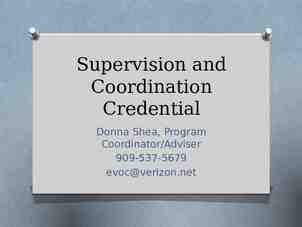Scope Change Control
13 Slides393.58 KB

Scope Change Control

Top 10 Reasons Why Projects Fail #1 Scope Creep The PMBOK Guide describes scope creep as “adding features and functionality (project scope) without addressing the effects on time, costs, and resources, or without customer approval” (PMI, 2008, p 440). Change on projects is inevitable, so the possibility for scope creep is also inevitable. #2 Overallocated Resources #3 Poor Communications #4 Bad Stakeholder Management #5 Unreliable Estimates #6 No Risk Management #7 Unsupported Project Culture #8 The Accidental Project Manager #9 Lack of Team Planning Sessions #10 Monitoring and Controlling Stewart, Jim (October 3, 2018). Top 10 Reasons Why Projects Fail. Project-management.com 2

Change and Impact of Change on Projects Project teams work in an uncertain environment. Plans cannot be made with 100% confidence Changes are inevitable and natural and it is important to successfully manage them Changes can be requests for additional features, deliverables, or work Any change that has the potential to impact expectations should follow a formalized change request, approval, and communication process Poorly managed scope change control can have a negative impact on cost, schedule, resource management 3

Define Preliminary Scope: Project Charter Clearly define high-level Scope within the Project Charter to ensure that everyone is on same page Clarify Objectives, Major Deliverables and establish Critical Success Factors End-state goal is to have a documented, agreed upon preliminary scope Emphasize to stakeholders and sponsors unfamiliar with PMO’s structured approach to managing projects, that accepting a preliminary scope of work outlined in the Project Charter does not mean that there can be no further changes for the remainder of the project 4

Define, Document, and Communicate Change Request Process Ensure everyone understands that a structured approach to requesting, evaluating and approving change requests will be followed Determine the limits and levels of authority for approving a requested change. – What type of request can be approved internally by PM? – What needs to be escalated to the project sponsor? – What needs to be reviewed by a change control board or governance council? Determining these decision points in advance can prevent misunderstandings around how change will be managed throughout the life of the project Document process in Change Management Plan 5

Document and Validate the Full Scope of Work Initial high-level views are not sufficient for understanding scope until a decomposed deliverable-based work breakdown structure (WBS) is created. Without the detail of a full WBS, a gap in understanding will exist. If the high-level scope is not clarified further with a detailed and validated requirements analysis, then the gap grows wider. Business analyst can contribute to clear scope with effective requirements elicitation and by analyzing and documenting clear, complete and concise requirements. Larson, R. & Larson, E. (2009). Top five causes of scope creep . and what to do about them. Paper presented at PMI Global Congress 2009—North America, Orlando, FL. Newtown Square, PA: Project Management Institute. Create the Work Breakdown Structure with project team Plan to the level of detail necessary to manage the work effectively – Decomposing work packages beyond the level required for effective management is unnecessary Freeze scope once project work is agreed upon via WBS Future changes to scope are ok, as long as they to follow scope change control process 6

Managing Change Requests If Change Request is received: Complete Impact Analysis** to ensure that everyone understands what the change request does to the project (impact to scope, schedule, budget) Make decision to Approve/Reject or Defer – Use previously defined Change Request Process process) Update Change Log If approved, update plan to include new objectives ** see Change Impact Assessment Process 7

Execute Project and Manage Change Related to scope from project planning perspective, we’ve: – Documented preliminary scope (Project Charter) – Defined and documented scope change request processes – Developed WBS – Frozen initial scope Manage project according to your scope change control process and change management plan 8

Project Completion and Final Acceptance Know that a project is complete when business objectives identified in the project charter have been delivered, along with approved scope changes Sponsor acceptance is defined as the formal recognition that the objectives and critical success factors defined in the original agreed upon scope of work, plus the objectives agreed upon in all of the formally approved change requests, have been met Document as part of Project Closeout process 9

Appendix 10

Sample Scope Change Control Process Core Team Members and Project Manager Project Change Order Process Project Manager communicates decision; business process change Identify need for change request and initiate change request form Executive Steering Committee Project Manager No Evaluate Change Request and impact on project scope, schedule, costs Business Owner presents Business Case Project Manager Drafts Change Order Project Manager reviews impact and determines action Proceed? Yes 11

Sample Scope Change Control Process 12

References Millhollan, C. (2008). Scope change control: control your projects or your projects will control you! Paper presented at PMI Global Congress 2008—North America, Denver, CO. Newtown Square, PA: Project Management Institute. 13






